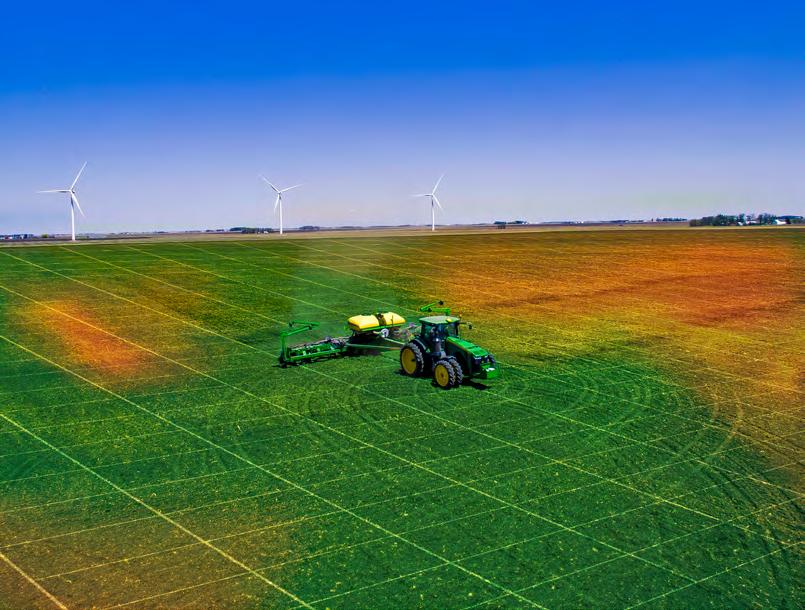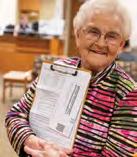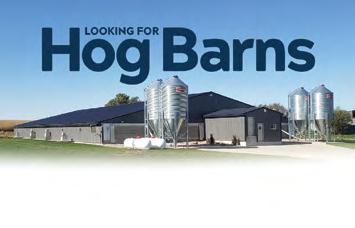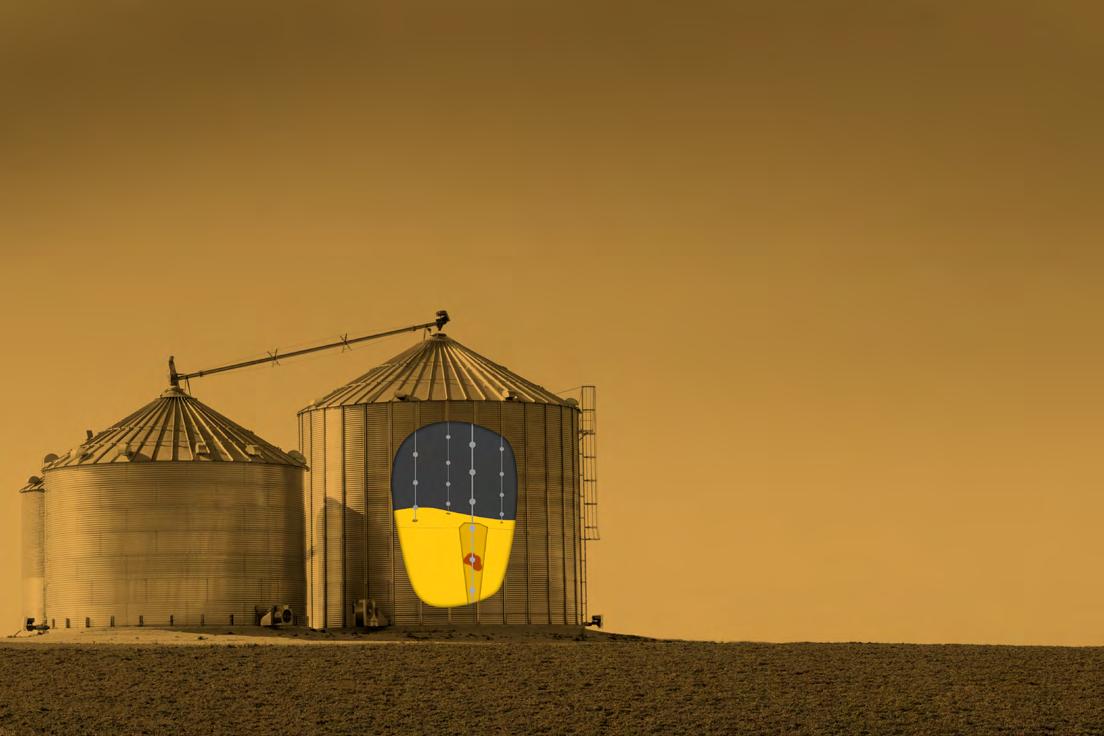






































The past five years have flown by like a rocket racing to the moon. Time flies when you’re having fun.
This month marks five years since AGE Media & Promotion started publishing The Farming Families magazine in Iowa. Through a somewhat chance encounter, I met AGE Media co-founder Garrett Gross in the fall of 2018. At the time, Garrett and his wife, Mindy, were publishing a South Dakota version of The Farming Families magazine. I asked Garrett if he’d ever thought of publishing a similar magazine in northwestern Iowa. “Well, yes, yes, I have,” he said. “I’ve just been looking for the right guy to be my boots on the ground.”
Fortunately, I think I’ve proven to wear the right size boots.
Our first issue launched in May 2019 with feature stories on the Don and Claudette Winterfeld family of Sioux Center and the Dean and Linda Meyer family of Lester. Those families took a leap of faith to let their stories be told in a brand new magazine. I’ll always be grateful that we were fortunate enough to get two such sincere and honorable families to start us on the right foot. The same can be said for the Jim and Rosie Staab family of Remsen who were our first featured family when we added Plymouth County in January 2020.
store in Rock Rapids, Rock Valley or Remsen. Remind me of your name and town and then your family’s story will pop right into my head!

Oftentimes, farming is an occupation consumed by numbers, be it bushels to the acre, rate of gain, contract futures or the amount of rainfall that’s being promised for next week. Those numbers are important as you determine how to farm. But numbers don’t really factor into the formula at The Farming Families. We’re not a magazine about how to farm. Rather, we’re a magazine about people who farm.
We’ve done stories on big farms and little farms. But our stories typically don’t tell you how many acres a family farms or how many head of cattle or pigs they’re feeding. Our starting point is: Do you make some or all of your living from agriculture? If the answer is yes, we want to tell your story. And, despite what some people say to me, everyone does have a story. Some of you might not even know what your story is, but that’s ok –I’ll find it as I listen to you and later check my interview notes. Sometimes I don’t even know your story until my fingers start typing.
I’ve interviewed stock growers and cattle feeders and pork producers and even a few goat farmers. Nearly everyone grows some corn and soybeans. Many also work a town job or have a unique side business. Over the past five years, I’ve interviewed about 150 families in northwestern Iowa, plus done stories on local history, our advertisers and other people of interest in our rural communities. That’s a lot of names to remember – I hope you’ll excuse me if I forget your name when we run into each other at the convenience
I’d be completely remiss if I failed to mention our advertisers. The companies who advertise here pay for the magazine and pay my salary. I tell them thank you every month and I hope you’ll tell them thank you as well.

Lance
The Alvord pork producer and farmer started registering Berkshires in 2010. They tested their genetics at the National Barrow Show up to 2015. Starting in 2017, the American Berkshire Association (ABA) began its own progeny test based on the original NBS Progeny Test, the gold standard in meat animal evaluations. To evaluate growth and feed efficiency, breeders from all over the nation enter eight pigs out of one sire and they go on test at a central location (currently Penn State University) for the grow out period. Then meat quality research is done on each individual pig at Purdue University. Fly’n K Berkshires has progeny tested 32 herd sires between 2013-
2021 and 12 of those sires have earned an award for high meat quality within the Berkshire breed. Those results have helped drive the family’s breeding stock sales. Fly’n K has seven sires on test in the 2024 ABA Progeny Test.
According to Lance’s wife, Kristi, “You don't have to go off our word. We think the proof is in the pedigree. All of our Berkshires are registered and we’re testing those genetics.”
Lance has extensively utilized the STAGES (Swine Testing and Genetic Evaluation) program to identify superior maternal animals in their herd. Fly’n K Berkshires have nine of the top 10 Berkshire sows in the nation right now on the Sow Productivity Index (SPI), which ranks individuals for reproductive traits based on their EPD’s for number born alive, number weaned, and 21-day litter weight.
Before the family zeroed in on breeding Berks, their journey into the purebred world started with an old-fashioned taste test at the family dinner table. “Around 2000, I can remember butchering some pigs at a locker. The pork was dry




and tough, so I got on this quest for something better. I had sourced some Berks and some Durocs and some meat quality Chester Whites. I dabbled with a few sows,” said Lance. “What we noticed was that the kids ate the Berk pork. The other stuff they’d just chew up and spit it out onto the side of the table.”
Kristi said passing the family taste test continues to be an important part of their research and development. Her freezer always contains pork from several different animals. “We’ll take chops from three or four different animals and cut them into pieces and put a bunch of toothpicks in them. It’s not scientific, but it’s a real test of the taste.”
Lance’s parents, Ezra and Marie Knobloch, had a typical diversified family farm. His mom had laying hens and they sold broilers in the spring. His dad grew corn, soybeans and alfalfa; plus had about 50 sows in a farrow-to-finish set-up and fed some cattle.
Lance graduated from Iowa State University in 1994; and he and Kristi were married in 1995. Kristi is a native of McLean County, Illinois, where she also was raised on a hog farm. In addition to hogs, Knoblochs grow corn and soybeans and practice strip tillage. All their corn is non-GMO, something Lance started doing in 2012 on the
recommendation of some friends who said their hogs were healthier on it. He decided to try it, provided it didn’t cost him any yield. Lance and Kristi’s son, Kelwin, said, “We haven’t seen any yield loss. In fact, our farm is producing corn yields far in excess of the county average.”
Lance said, “When I returned to the farm, my dad was 66 years old and he’d done all the adapting he was going to do. This was right at the beginning of the major shift to large confinements in this area.” Over time, Knoblochs moved from being farrow-to-finish to being farrow-to-wean and then doing custom feeding. The hog market crash of 1998 forced the family to continuously adapt and experiment






to try to survive. “It wasn't an easy ride, let me put it that way. There were disease problems and lots of learning.” The family has two double-wide finishers and owns shares in a Pipestone sow unit for their commercial hogs.
Kristi added, “We have the luxury of having our feet in both sides – the commercial pigs and the breeding stock.” Lance continued, “Alone, the Berks couldn't justify the feed mill we own, but the commercial pigs allow us to have the mill for both herds.”
Kelwin lives a mile-and-a-half away. He’s in charge of the

commercial herd, feed mill, and manure application in the fall. He’s a graduate of South Dakota State University and works full-time as a production supervisor with Idlenot Farms of Larchwood. His mom said, “Kelwin was a pig guy from the day he was able to go outside by himself. He showed 4-H pigs and guided his brothers through it, whether they wanted to or not.”
In the purebred herd, Fly’n K focuses on sow productivity, meat quality and overall robustness. “There's no other way to say it –we’ve been able to identify genetics that put us on the map,” Lance said.
Fly’n K Berkshires has sold its breeding stock across the country. “Our customer relationships have been a great blessing. If our customers face a problem in their herd – whether it’s with the animals we sold or not – our service extends beyond the sale to help them be successful.”
Finished Berkshire hogs from Fly’n K Farms are shipped to Berkwood Farms in Des Moines, a coalition of over 80 independent family farmers. Producers deliver a total of 700 pigs a week, which are then harvested at Pine Ridge Farms, a custom processor. The meat is sent to other facilities for further processing. “It's been a really big success for us. If you want to raise pigs and have less than a couple thousand sows, a group like this is the only way you can compete in the marketplace. This producer-owned co-op allows us to get a premium for our Berkshire pigs.”
The high flavor and tender Berkshire pork product is in demand on the east and west coasts of the U.S. and overseas in countries such as Japan. Thirty percent of the co-op’s market is in California. Berkwood Farms is the only farmer-owned company with national distribution, including sales to America’s top chef-owned restaurants and national grocery stores.
According to Lance “I tell our customers ‘If you chase two rabbits, both will escape.’ That’s why we keep our focus on Berks and no other breed. If you take your eye off the ball, any of those pigs from another breed or cross other than registered Berkshire will only be worth commodity pig prices.”
Lance and Kristi’s son, Gabe, maintains large earth and coal moving equipment in Beulah, North Dakota, for The Coteau Properties

Company’s Freedom Mine. His job is three weeks on and one week off. Gabe said, “I come home on my week off to do machinery maintenance and repairs and a little upkeep all around, plus help with chores or whatever.” Gabe is a graduate of the diesel mechanics program at Lake Area Technical College in Watertown, South Dakota.
When available, Gabe is the primary hauler of pigs to Berkwood Farms. He has hauled pigs to the ABA Progeny Test at Penn State for several years. From Alvord, he works his way east across the country picking up pigs from several producers.
Lance and Kristi are frequently on the road visiting their son, Keegan, and his wife, Callie. The visits provide time with the “cutest grandsons ever,” Cort, 2½, and Lincoln, 10 months. Keegan is a commercial pilot for Air Charter Express based out of Milwaukee. The company often transports college sports teams such as the SDSU women’s basketball team. He has an aviation maintenance degree, also from Lake Area Technical College.

Youngest son, Dayton, will graduate in May from Des Moines Area Community College with a degree in marketing. His college experience included time on marketing projects for Berkwood Farms. He will study abroad after he graduates from DMACC.
Kristi said, “It's been good life. Everybody's been healthy and hardworking. We always encouraged the boys to take time to work for others in something they have an
interest in. You don’t want to tie them down to the farm if there’s a chance they’re going to be miserable here.”
Lance stays busy as an advocate for the Berkshire breed through service on the board of the American Berkshire Association. “Somebody has to do the work or the stuff is going to die. With the progeny tests, I'm a big part of keeping that going,” he said.

The offer process may vary depending on whether your purchase is through a real estate agent or private sale. Going through a real estate agent simplifies the process a bit for buyers and parallels a home purchase. Typically, the agent prepares the necessary documents, such as a standard offer form, puts your down payment into a non-interest-bearing escrow account and works with a title company to clear the title.
Now suppose your landlord unexpectedly passes away and his heirs want to sell the farm ground you have been renting for years. This process is tougher to work through than a listing from a real estate agent because you will need to do more of the legwork, beginning with negotiating an offer and handling the details of an offer to closing on the deal.
Negotiating a purchase price can be intimidating. A real estate agent can guide you through the price or range listed on the farm. If you are not working with an agent, you will negotiate the price directly with the seller. In cases where the land isn’t listed, you may need to call
the seller and have a conversation about price. Usually, neither party likes to be the first one to throw a number out. However, as a buyer, you can be prepared by researching land values in the area or other appraisal data that may be available near that location. But keep in mind, each property is different, so it may not be a perfect comparison.
When making an offer, be transparent about how you arrived at your number – the data you looked at, the process you followed. This will give you better leverage for negotiating.
If there is an established relationship with the seller or emotions are involved, be aware that negotiations can be tough. No one wants to insult a seller or ruin
an existing relationship. In these cases, it’s more important than ever to do your homework and be informed.
Once you agree on a price, it’s a good idea to have an attorney draft a purchase agreement. If the seller has a purchase agreement drafted by an attorney, have your attorney review the agreement. You'll also want to work closely with your lender on the financing side in order to feel confident about making an offer and executing a purchase agreement.
A title company will help handle the details of the closing. All title companies are different, and some
have more experience in farmland than others. It’s a good idea to get a recommendation from your lender or another person you trust.
Several people will be involved in your closing process. This includes the seller, real estate agent (if applicable), title company and/or attorney as well as your lender.
The title company or attorney handling the closing should notify you of the closing date and what you will need to bring. Typically, there is a settlement sheet, which outlines who is responsible for the various fees outlined in the purchase agreement. There may also be a document that shows the proration of real estate taxes (e.g. who’s responsible for what part). A real estate form will also be provided and signed at closing (this makes
sure the taxes get transferred over to the right person). The title company will let your lender know how much the mortgage or deed of trust needs to be made out for. Finally, if you’re putting money down, you will need to bring certified funds to the closing.
If both the seller and buyer are motivated and serious, a transaction can move quickly and be completed in 45 to 90 days. But many factors will determine how long it takes to complete your transaction. For example, selling a farm in August with a crop on it can complicate things. You may do your negotiating in August. But closing might not happen until December or January and the buyer would get possession for the next crop year.

WHO WANT TO BE A PART OF
There are several situations that could delay or derail the process. Here are a few:
• The title company discovers a lien on the property that the seller wasn’t aware of.
• A previous lien wasn’t released by the bank when a loan was paid off.
• The seller has past-due taxes that need to be brought current before closing.
• An appraisal condition must be satisfied before closing.
• Something happens with the buyer’s financing. It’s a good idea to put in the written offer that the purchase is subject to financing. This protects you by giving you an out in case your financing falls through.
For information on additional financial topics, see www.fcsamerica.com.














“Comets” was a fitting mascot for Hawarden High School graduates in the 1950s. Junior high and high school boys had their eyes trained on the heavens – on the lookout for Soviet aircraft – perched in the bell tower of the old Hawarden Central School. From 1950 to 1958, young men across the country took part in the Ground Observer Corps, an arm of the United States Air Force Civil Defense service.
Sound far-fetched? Well, it wasn’t. From 1953 to 1958, Hawarden was part of the Ground Observer Corps (GOC) because the town was along the logical flight path of Soviet jets which might descend from Siberia to bomb the U.S. Strategic Air Command at Omaha. Observers were trained to identify the silhouettes of various aircraft. The Hawarden post (identified with the code: Juliet, Nectar Three Five Black) had a direct line to SAC headquarters. (In Iowa alone in 1954, there were 13,000 volunteers in the program.)
The American Legion sponsored the local observer post and Don Dowdey was the supervisor. According to Hawarden native Mary Truesdell Johnson, a 1957 HHS graduate, the Ground Observer Corps (GOC) experience was one of life’s highlights for her late husband, Jules. She said being a part of the corps was a frequent discussion topic at class reunions. “They thought it was the greatest thing they ever did. And they talked about it every time we’d get together.” Female students were jealous they couldn’t participate or even visit the bell tower.
Ron Thompson, a 1957 HHS graduate, wrote: “I was 14 years of age and proud to be a member of the Hawarden Ground Observer Corps when it was formed in 1953. Like all the volunteers, I took the responsibility that the corps shouldered very seriously. We were part of our country’s early warning system against an enemy warplanes invasion. The USSR had ‘the bomb’ and we were doing our part to fight the Cold War.”
Thompson continued, “When my team of observers was scheduled for duty, I made sure that I was on time to relieve the previous observers. No one in the corps wanted to be responsible for breaking the continuity of our air watch patrol and allow an enemy plane to slip by without it being reported to GOC central at Offutt Air Force Base.”













The late PBS and NBC political analyst Ken Bode grew up in Hawarden and received a “Lavender Heart” during a class of ’57 reunion. He was “injured in the line of duty” as a member of the Ground Observer Corps. The Lavender Heart is shown here with a note he wrote to Mary Johnson.
From Central School’s third floor, observers climbed a narrow ladder up to the open air belfry. On a small table in the little square room sat their observation gear: A pair of binoculars, a duty roster, and a black telephone. Next to the phone was the GOC Aircraft Recognition book containing silhouettes of every plane ever built. Plenty of pigeons helped the observers keep watch.
Ken Bode, a political analyst for NBC and CNN and the moderator of Washington Week on PBS, was a 1957 graduate of Hawarden High School. He was also a journalism

professor at Northwestern University, DePauw University and other colleges. Bode told Mary Johnson, “The first time I ever felt like a man was when I took my lunch pail and I went up to the tower to watch for enemy airplanes.” Bode received a gash on his head when a 2x4 fell down the ladder hole while he was on his way up. He later received an unofficial “Lavender Heart” to recognize the “injury” he suffered during the Cold War.
Stuart Flynn was a 1956 HHS graduate. One year on Armed Forces Day, he and Jules Johnson were on duty when suddenly the tower was

being buzzed by two thundering jet fighters. Flynn said, “The roar of those two fighters was deafening … they were probably less than 500 feet off the ground and made at least a couple passes at us. For a brief moment, I thought we were under attack by the Russians!” Jules called the report in to Offutt Air Force Base. They eventually determined it was friendly aircraft – two P-51 Mustang Fighters from the Air National Guard in Sioux City.
-Most of this story is excerpted and adapted from an article written by Mary Truesdell Johnson in 2012, Hawarden’s sesquicentennial year. Combining








At Premier, we know the importance of fast, reliable connections. That’s why when we install fiber optics, we don’t just bring the connection to your home. We will also bring fiber to your hog and dairy barns, shops, and accessory buildings. Get your home and operation up to speed with access to fiber and the best services from Premier Communications.





Farmers are eternal optimists and always start the growing season planning, hoping and praying for a record crop. But sometimes the vision of a bumper harvest is tarnished with the unexpected arrival of diseases such as white mold or sudden death syndrome in soybeans; or Goss’ wilt, crown rot or tar spot in corn.
Local crop nutrition consultants
Verlyn Sneller and Dennis Von Arb have introduced a new product called Biomentum Foliar Plant Nutrition which helps farmers stay ahead of disease problems in both corn and soybeans. Sneller owns Terra Transitional Solutions of Orange City and Von Arb owns Nutritional Ag of Alton. Starting 15 years ago, the pair became local pioneers in the use of micronutrients and carbon to enhance crop yields. They’ve been testing
the Biomentum product in local fields since 2016.
According to Von Arb, “In the last few years, we were able to test Biomentum in drought conditions. Drought challenges the nutrition of plants and actually sets them up for more diseases than rain does. A drought cycle will leave the plant devoid of that mechanism to digest nutrients from the soil. So it becomes more susceptible to diseases which don’t tend to
express themselves until later in the season. That's when the real economic loss hits.”
Sneller continued, “With Biomentum, our approach is prevention. The problem with late season treatment is the damage is already done. We don’t want farmers to put a band-aid on it –because that's too expensive and usually too late. Whether we put it in furrow on soybeans or foliar it before V7 on corn, we’ve got lots of







A lifetime of care starts here.







numbers from local test plots to show it works. Farmers want to see numbers – why would they use it otherwise? It’s very important to us to test every year so we can show farmers a return on investment.”
The product goes to work using the following ingredients:
Nine different mycorrhizae cultures which makes nitrogen, phosphorus, potassium, zinc, calcium, iron, magnesium and manganese into a plant-available form.

Three different saprophytic fungi that recycle nature, destroy pathogenic fungi (cell wall borers), and destroy bio-nematicide fungi (insect eggs, juveniles and adults).
Nineteen different bacterial cultures.
Biomentum contributes to both plant health and soil health by breaking down and making available more of the natural and farmer-applied nutrients that are in the soil. “We're using this biological to prevent both fungal and bacterial diseases on crops,” Sneller said. “In the fall, everybody sprays a fungicide, but fungal leaf diseases are only 50 percent of the diseases that affect any crop. The rest are bacterial; and the problem is there aren't any good solutions on the market for leaf diseases like Goss's wilt in corn.” Biomentum is unique because it covers both bacterial and fungal diseases.

Diseases “plug up” the circulatory system of a plant. Biomentum helps corn and soybeans produce more exudates (biological food), increasing biological activity and, thus, helping nutrients better reach the leaves going up and the roots going down. Von Arb said, “All diseases are related to crop nutrition. The better the balance of nutrition, the better you control diseases. Healthy plants make for healthy soil. Healthy soil does not compact!” Their test plots have shown that the effect of the product is cumulative, year after year. To














Here's a little humor to wrap up this month's issue. When I meet with families, I record the interviews to help ensure I get the story straight. I put the recordings in an online transcription app, which is supposed to give me nice document of what was said. It’s supposed to be nice. Oftentimes, however, the app can’t hear any better than my hearing aids can. For example, you said, “I grew up on a dairy farm by Mashalltown,” but the computer app heard “grew up in dirt by muscle.” Another example: You said, “You have to use section 129 and stuff like that.” But the app heard “You have to use sexualized zodiac signs and stuff like that.” Needless to say, this is why we can’t trust AI (artificial intelligence). Here’s a further sampling of what farm families said and what the computer app heard …
milk cows dog scouts
Carmel karma
Calving caffeine
Customer custom manure
Turner County Fair Turd County Fair
ice cream for the grandkids a scream every night
Go to sale barns boat sail burns
Hutterites food rights
Sheep are cheaper
I love to help calvin’ I'd love to help Kevin
Simmentals scimitar holes
Simmental world cemetery world
A bunch more debt bench warrant
Wayne Bietelspacher lady beetles blacker












712-947-4833 | Hwy. 75, Hinton, IA www.TNTSales.net

Shallow Creek Consulting is looking for hog barns for swine operations that we work with and manage. If your barn is coming open or you are looking for a change, give us a call and see what we have to offer.
Shallow Creek Consulting works with pork producers in managing facilities, record keeping and cost management.
INGREDIENTS:
1-14 oz pkg smoked sausage, sliced
1 lb baby red potatoes, quartered
1 lb green beans, trimmed
2 cobs of corn, cut into coins
¼ c butter, melted
½ tsp black pepper
1 tsp salt
Parsley, optional garnish
Cut four large sheets of foil
DIRECTIONS:
1. Divide the sausage, potatoes, green beans, and corn evenly among the pieces of foil.
2. In a small bowl, combine the butter, pepper, and salt; pour over each foil packet, dividing evenly.
3. Fold the foil packets and seal tight; give each packet a little shake to evenly disperse the butter.
TO GRILL:
Place on a hot grill and cook until potatoes are soft (12 to 15 minutes); open and garnish with parsley if desired.
TO BAKE:
Place the foil packets in a 425-degree oven. Bake for 20 minutes or until the potatoes are soft; open and garnish with parsley if desired.









G o o d h e a l t h , i n c l u d i n g m e n t a l h e a l t h , i s a k e y f a c t o r t h a t c o n t r i b u t e s t o o n e ’ s a b i l i t y t o k e e p f a r m i n g . A t S i o u x C e n t e r H e a l t h , w e e n c o u r a g e y o u t o t a k e c a r e o f y o u r p h y s i c a l a n d m e n t a l h e a l t h i n a l l s e a s o n s , i n c l u d i n g t h i s p l a n t i n g s e a s o n .
